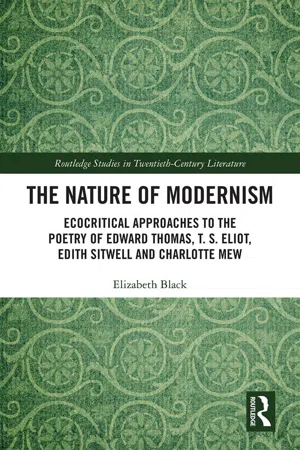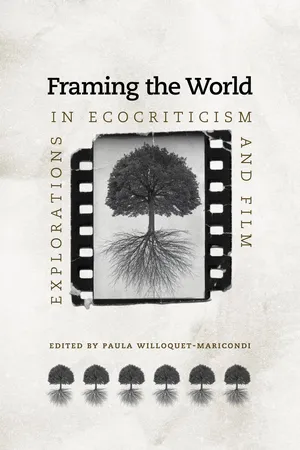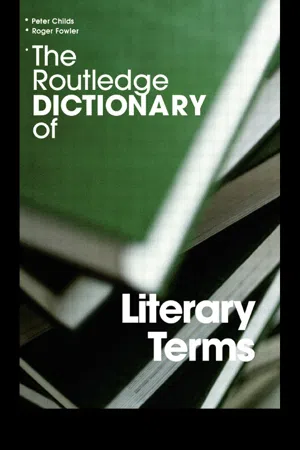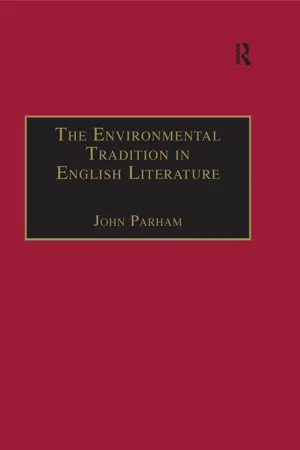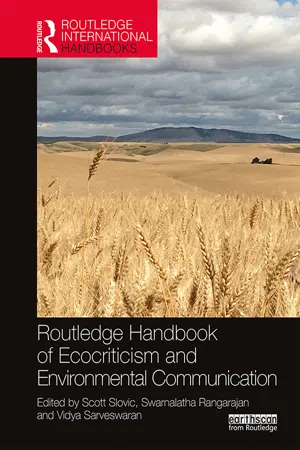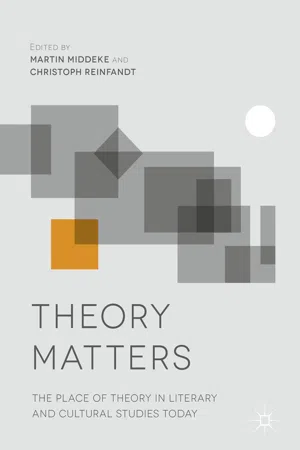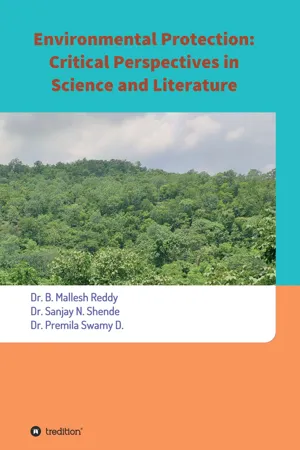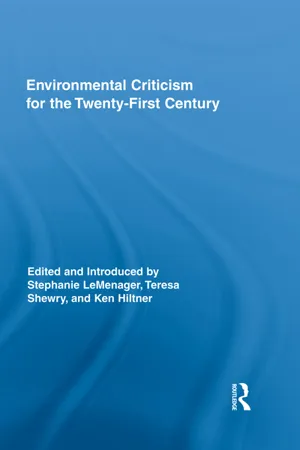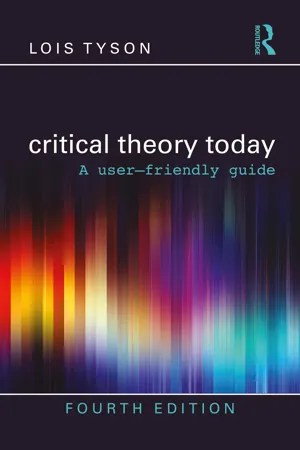Literature
Eco-Criticism
Eco-criticism is a literary theory that examines the relationship between literature and the environment. It explores how nature is represented in literary works and how these representations reflect and shape societal attitudes towards the environment. Eco-criticism also considers the role of literature in promoting environmental awareness and advocating for ecological sustainability.
Written by Perlego with AI-assistance
Related key terms
11 Key excerpts on "Eco-Criticism"
- eBook - ePub
Contemporary Literary and Cultural Theory
An Overview
- Jeffrey R. Di Leo(Author)
- 2023(Publication Date)
- Bloomsbury Academic(Publisher)
CHAPTER ELEVENEcocriticism
11.0 INTRODUCTION
Ecocriticism is an abbreviation for ecological literary criticism. It can be traced back to the late 1970s, where it was coined by William Rueckert in “Literature and Ecology: An Experiment in Ecocriticism” (1978). However, it was not until the late 1980s and early 1990s that it began to be used with some frequency to refer to an interdisciplinary field in literary and cultural studies. Cheryll Glotfelty is credited as reviving the term in 1989 as an alternative to a domain within literary and cultural studies that was formerly referred to as the study of nature writing.Ecocriticism, or, alternately, green theory, might be regarded as concerned with the following:(1) The Environmental Imagination—ecocriticism analyzes the role that the natural environment plays in the imagination of a cultural community at a specific historical moment;(2) The Concept of Nature—ecocriticism examines how the concept of “nature” is defined;(3) The Value of Nature—ecocriticism asks what are the values that are assigned to nature or denied it and why;(4) The Relationship between Humans and Nature—ecocriticism explores the way in which the relationship between humans and nature is envisioned;(5) Literary Genres—ecocriticism investigates how nature is used literally or metaphorically in certain literary or aesthetic genres and tropes. It also explores the assumptions about nature that underlie these genres and tropes; and,(6) Environmental Activism—ecocriticism intervenes in current social, political, and economic debates surrounding environmental pollution and preservation.1Moreover, though the terms ecocriticism and green theory are often used interchangeably, some use the former term in a more narrow sense to refer only to the study of literature and nature; and the latter term in a wider sense to refer not only to the study of literature, but also art, film, music, politics, and philosophy in relation to nature. In addition, it might be noted that ecocriticism is the preferred term in the US, whereas green theory - eBook - ePub
The Nature of Modernism
Ecocritical Approaches to the Poetry of Edward Thomas, T. S. Eliot, Edith Sitwell and Charlotte Mew
- Elizabeth Black(Author)
- 2017(Publication Date)
- Routledge(Publisher)
72 The open, cross disciplinary and inclusive ethos has made ecocriticism a popular and rapidly developing area of literary study.Such expansive definitions have given ecocritics freedom to examine almost any text from an earth-centred perspective and have encouraged the extension of ecocritical practice beyond more explicitly nature-centred texts into areas of literature, such as modernism, which have more complex relationships with place. However, ecocriticism’s openness of interpretation has made it difficult to find consensus on its central aims and beliefs, leading to accusations that the theory is not united by definite theoretical standpoints or shared methodologies, but by a more general focus on the environment. Previously Patrick Murphy criticised ecocriticism for remaining ‘theoretically unsophisticated’, claiming that ‘too often, there remains an anti-theoretical, naive, realist attitude’ in the work of ecocritics.73 John Parham agrees, stating that ‘from its inception ecocriticism adopted a belligerent attitude towards critical theory’.74 In particular, he identifies the need to redress simplistic divisions between nature and culture in early ecocritical thinking, to develop theoretical ideas around scientific ecology and to avail of opportunities to advance the social and political dimensions of the theory.75 Lawrence Buell attributes the degree of ambiguity surrounding ecocriticism’s theoretical foundations to its ‘history both of strong position taking by individual spokespersons and of reluctance to insist on a single normative, programmatic definition of its rightful scope, methods and stakes’.76 Stephanie Sarver agrees, regarding ‘ecocriticism’ as ‘an unfortunate term because it suggests a new kind of critical theory’ whereas in reality ecocritics ‘draw on a variety of outside theories, such as feminist, Marxist, post-structuralist, psychoanalytic and historicist, rather than creating their own’.77 For David Mazel, the absence of definite theoretical values is damaging because it means that the movement lacks a unity of purpose: ‘No matter how it is defined, ecocriticism seems less a singular approach or method than a constellation of approaches, having little more in common than a shared concern with the environment’.78 However, Gillian Rudd finds the idea of definitive theoretical standpoints incompatible with the theory’s essential character: ‘ecocriticism cannot be a school that seeks to create and maintain a single, uniform outlook. Central to ecological thinking in general is a recognition of the importance of diversity – of species, of environments and even of approach’.79 - eBook - ePub
Under the Sign of Nature
Explorations in Ecocriticism and Film
- Paula Willoquet-Maricondi, Paula Willoquet-Maricondi(Authors)
- 2010(Publication Date)
- University of Virginia Press(Publisher)
The Environmental Imagination: (1) works in which the nonhuman world is not mere backdrop for human action but helps us situate human history within natural history; (2) works that do not single out human interest as the only significant interest; (3) and works whose ethical orientation includes human responsibility and accountability toward the environment and the nonhuman sphere (7–8). At the same time, and as some of the essays in this collection will make clear, ecocriticism enables us to identify other types of texts that are not “self-evidently about nature” (Barry 259) but that nonetheless offer us needed perspectives on the relations between the human and the nonhuman.Ecological literary studies became a recognizable and consolidated critical school in the early 1990s, although its origins date back to the 1960s and ‘70s. The term “ecocriticism” has a history of its own, having first been used in 1978 by William Rueckert to refer in a more restrictive way to the application of ecological concepts to literature (Glotfelty xx). Literary ecocriticism today includes the study of nature writing as a genre; it examines the role of the physical setting in literary productions, the values expressed in relation to the environment, and the correlation between what a culture says about the environment and how it treats it; it conceives of place as a critical category; it looks for correspondences among gender, class, ethnicity, and nature; it asks how culturally produced texts affect our relationship with the natural world; it traces changes through time in a culture's concept of environment; and it examines representations of the environmental crisis in literature. In short, ecocriticism acknowledges that the world is composed of the social sphere and the ecosphere, that the two are interrelated, and that the former cannot be considered outside the context of the latter.The practice of something analogous to literary ecocriticism has even older roots. Before the term was ever used, the study of textual engagement with the nonhuman world from an ecological standpoint had already commanded the attention of students of philosophy, ethics, and critical theory. One of the first efforts to address the ecological crisis from within critical theory, and at a time when ecological consciousness was only beginning to surface in popular discourse, is Joel Whitebook's 1979 essay “The Problem of Nature in Habermas.” In this essay White-book argues that the domination of nature is a constitutive feature of what we call the modern era, roughly spanning from the seventeenth century to now, notwithstanding our current claims as postmoderns. Whitebook begins his investigation by asking whether a strictly anthropocentric perspective could meet the challenges of an ecological crisis of such unprecedented dimension. He writes, “Even if it could be shown theoretically - eBook - ePub
- Peter Childs, Roger Fowler, Peter Childs, Roger Fowler(Authors)
- 2006(Publication Date)
- Routledge(Publisher)
EEcocriticism The study of literary texts with reference to the interaction between human activity and the vast range of ‘natural’ or non-human phenomena which bears upon human experience – encompassing (amongst many things) issues concerning fauna, flora, landscape, environment and weather.Although ecocriticism is principally part of a wider response to a modern environmental crisis, its roots lie in what its adherents perceive to be the ‘human-centric’ model of history originating with the Greeks. The latter were the first to focus on ‘Man Apart’ – that is, humankind without reference to the physical environment in which the species subsists, – as merely one element of a complex ecosystem. For ecocritics, history since the Greeks testifies to the triumph of ‘Man Apart’, and the marginalization of any perspective attempting to re-integrate humankind into the natural environment.‘Man Apart’ came into his own with the Age of Enlightenment and the onset of industrialization. The task of science since the eighteenth century has been the domination of nature through the accretions of rational knowledge. During the same period, the industrial imagination roamed unchecked throughout the world, constantly searching (much of the time aided by scientifically derived knowledge) for ways to better exploit the planet’s natural resources. Ecocriticism emerged at a time (the latter half of the twentieth century) when, after centuries of systematic exploitation, many of those non-renewable resources were nearing the point of exhaustion. As such, it may be regarded as the literary critical wing of a general ‘green’ consciousness that has emerged in the developed world since the Second World War.There are two main impulses or strands to ecocriticism. The first addresses itself to the growing canon of ‘ecoliterature’ that has emerged in response to the global environmental crisis – imaginative writing which self-consciously engages with ‘green’ issues. In this respect, it is worth noting the ‘literary’ air which permeates much ecocritical writing itself; infused with the proselytizing nature of their subject, and naturally indisposed towards received critical discourses (which they perceive to be infected with the scientific spirit), ecocritics have a tendency towards ‘purple’ prose – writing that is intended to sway the emotions as well as engage the intellect. - John Parham(Author)
- 2017(Publication Date)
- Routledge(Publisher)
The Ecocriticism Reader, its common property can be defined as ‘the study of the relationship between literature and the physical environment’. Many of the questions ecocritics ask have been asked by literary critics for years: What role does setting play in the plot of a novel? What metaphors are used to describe the natural environment? What is the representation of the relationship between ‘man’ and ‘nature’? But other questions are not so obvious nor are they easily answered: ‘How do we characterize nature writing as a genre? In addition to race, class, and gender, should place become a new critical category? Do men write about nature differently than women do?’ These are some other examples that Glotfelty offers.The common premise of all ecological criticism, however, remains this:that human culture is connected to the physical world, affecting it and affected by it. Ecocriticism takes as its subject the interconnections between nature and culture ... As a critical stance, it has one foot in literature and the other on the land; as a theoretical discourse, it negotiates between the human and the nonhuman.1This tension between the human and the non-human is part of the philosophical dilemma that faces ecologists and writers alike. Many ‘nature writers’ speak on behalf of the Earth or its creatures precisely because they feel that humanity is turning a blind eye to environmental destruction; some ecologists however, such as those allied with the deep ecology movement, fault writers who presume to speak for the natural world, finding in this act one more example of human hubris or anthropocentricity as they put it. So one further question ecocriticism might ask of ‘nature writers’ or poets is how they speak for the Earth and whether that speech is valid.- Scott Slovic, Swarnalatha Rangarajan, Vidya Sarveswaran, Scott Slovic, Swarnalatha Rangarajan, Vidya Sarveswaran(Authors)
- 2019(Publication Date)
- Routledge(Publisher)
INTRODUCTION Scott Slovic, Swarnalatha Rangarajan and Vidya SarveswaranWhat is ecocriticism and how has the field developed?
Although named in 1978 and officially recognized as a burgeoning discipline (or academic movement) in the mid-1990s, the field of ecocriticism (environmental approaches to textual analysis and cultural studies) has actually existed for a very long time, perhaps dating back to the earliest commentaries on natural themes in ancient sacred texts. David Mazel summarizes this development in the introduction to his 2001 collection, A Century of Early Ecocriticism , referring to the field as “the study of literature as if the environment mattered” (1). Mazel marks the onset of contemporary ecocritical studies of environmental texts and the cultural contexts of environmental communication as the publication of Leo Marx’s The Machine in the Garden: Technology and the Pastoral Ideal in America (1964), tracing “early ecocriticism” back 100 years to Henry Tuckerman’s America and Her Commentators: With a Critical Sketch of Travel in the United States (1864) and including Tuckerman’s essay on naturalists John and William Bartram as the earliest sample of proto-ecocriticism in his anthology. The field of ecocriticism has evolved and expanded tremendously since early studies of “nature-writing” (such as Dallas Lore Sharp’s work in the 1911 book The Face of the Fields ) and the focus on natural themes in literature (such as Norman Foerster’s 1923 monograph Nature in American Literature: Studies in the Modern View of Nature ).Those who adhere to the “wave theory” of ecocriticism have typically begun their historiography with William Rueckert’s “Literature and Ecology: An Experiment in Ecocriticism,” published in the Iowa Review in 1978, a work in which Rueckert argues that ecological concepts are embedded in the literary expression, especially in poetry, which he refers to as “the verbal equivalent of fossil fuel (stored energy)” (108). The initial wave of ecocriticism—the so-called “first wave”—appeared in the 1980s following Rueckert’s use of the term, although most of these scholars did not actually use the term “ecocriticism” to describe their work until Cheryll Glotfelty and Harold Fromm published The Ecocriticism Reader: Landmarks in Literary Ecology in 1996, helping to launch “ecocriticism” as a formally recognized branch of literary and cultural studies, although it took a number of years before the field gathered momentum and became the ubiquitous area of teaching, research, and even activism that it is today. In his 2005 volume The Future of Environmental Criticism: Environmental Crisis and Literary Imagination- eBook - ePub
Theory Matters
The Place of Theory in Literary and Cultural Studies Today
- Martin Middeke, Christoph Reinfandt, Martin Middeke, Christoph Reinfandt(Authors)
- 2016(Publication Date)
- Palgrave Macmillan(Publisher)
As an academic movement, ecocriticism first appeared on the scene of literary and cultural studies in the later twentieth century as a rather marginal and regional phenomenon in a phase when poststructuralist, new historicist, and discourse-analytical theories dominated the field (cf. Buell; Clark 2011; Westling 2013; Garrard). Meanwhile, it has become one of the fastest-growing areas of study and interdisciplinary research in the humanities. The emergence of ecocriticism represented a response of the humanities to the worldwide dimensions of an environmental crisis which modern civilization has brought about in its uncontrolled economic and technological expansionism. This crisis was experienced as a threat to the very foundations of human life and survival on this planet and has sharply brought into focus the existential dependency of human beings on the natural resources and ecosystems which have been exploited and instrumentalized in the name of unlimited civilizational self-empowerment. What this also entailed was an awareness that these fundamental conditions and vital interdependencies of human life within the larger web of planetary life had not only been marginalized in the dominant discourses and self-concepts of modern societies, but that they had also largely been absent from the prevailing categories of cultural studies and humanist scholarship. It is in response to this perceived inadequacy of long-inherited forms of anthropocentric thinking, including its modern and postmodern manifestations, that ecocriticism emerged as a new field of cultural and literary studies that aimed at widening the scope of scholarly attention and redefining the concepts of scholarly methodology in the light of the political, ethical, philosophical, epistemological, and aesthetic implications of this new ecological paradigm.The spectrum of contemporary ecocriticism crystallizes mainly around five different dimensions: a socio-political dimension in which texts are examined in terms of their explicit or implicit environmental agendas, with the aim of raising ecological awareness and of changing social and political practices, including gender issues in different versions of ecofeminism, or class and environmental justice issues in postcolonial versions of ecological thought; an anthropological or ecopsychological dimension in terms of addressing psychological disruptions and civilizational traumas resulting from the ecological crisis (cf. Hornung and Baisheng); an ethical dimension of ecocriticism in which a prevailing egocentric and anthropocentric value system is put to the test from an awareness of alterity or “answerability” to human and nonhuman “otherness” (cf. Murphy; Müller and Sauter); an epistemological dimension, in which linear-monocausal concepts of thought, agency, and time are questioned and superseded by non-linear concepts of complexity and recursivity; and an aesthetic - eBook - ePub
Extending ecocriticism
Crisis, collaboration and challenges in the environmental humanities
- Peter Barry, William Welstead(Authors)
- 2017(Publication Date)
- Manchester University Press(Publisher)
1Ecocriticism extends its boundaries Peter Barry and William WelsteadEnvironmental literary criticism, usually contracted to ecocriticism, has advanced considerably since the term was widely adopted in the 1980s and 1990s. The aim of this book is threefold: firstly to consider examples of this advance across genres within literary studies and beyond into other creative forms; secondly to explore the ecocritical implications of collaboration across genres in the humanities; and thirdly to explore literary, artistic and performance production through direct collaboration between the creative disciplines and the sciences.Although she was not the first to use the term ‘ecocriticism’ as a contraction of ‘ecological literary criticism’, its popularisation is attributed to Cheryll Glotfelty, who at a meeting of the Western Literary Association in 1989, proposed that the term ‘ecocriticism’ be used for what had previously been known as ‘the study of nature writing’. Her proposal was seconded by Glen Love, who had been thinking along the same lines. In a 2003 essay on Willa Cather she suggested that ‘the term ecocriticism for a critical practice that would take as its subject “the interconnections between human culture and the material world, between human and nonhuman”’ (see Glotfelty 2003 ). It is perhaps significant that ‘biodiversity’ as a contraction of biological diversity was also adopted in the same decade, when W.G. Rosen suggested its use at the 1985 National Forum on Biological Diversity.1 - Dr. Mallesh Reddy, Dr. Sanjay N. Shende, Dr. Premila Swamy D.(Authors)
- 2021(Publication Date)
- tredition(Publisher)
Silent Spring (1962). The fable lays emphasis on human interference in a state of essential changelessness giving way to catastrophic destruction. While some may disagree with such an alarmist prognostication no one will deny that man has irrevocably and irreparably damaged nature. Garrard is also right in stating that issues related to the environment have largely been the domain of ecologists and environmentalists and it is only more recently that literary and cultural analyses have supplemented scientific discourses on the subject.Ecocriticism has long outgrown its green and political agenda (Garrard, 3). It has emerged into a syncretised discourse in which a cultural eco-space occupies a significant expanse and places man right at the centre where he is portrayed as the ‘change’ agent both in terms of the destroyer and the possible redeemer. It allows for a transformative discourse which transgresses the disciplinary boundaries of ecology and focuses on ecological literacy (Garrard, 5) by studying how the human and the non-human have been interdependent throughout cultural history. The science of ecology lays stress upon the interrelationship between all living organisms and the environment. It focuses primarily upon affected ecosystems due to human intervention and establishes man as an integral part of the biosphere today (Saxena, 139).Cultural ecocriticism expands the spectrum of ecological studies and establishes that man’s relationship with the environment is characterized by various other factors than those outlined by the esoteric concerns of natural and social sciences. It would be prudent here to emphasize that ecocriticism is not an overtly moral discipline which tends to intrude into the normative discourses of environmental biologists and geographers but an approach to define, explore and resolve ecological problems from a literary perspective and widen the environmental debate.The German Geographer, Carl Ritter was amongst the first to propound the influence of environmental factors not only on human activities but also on human character. Man shares an intricate mutual relationship with his surroundings, although he is not always aware of it. The truth is that man owes to the land as much as the land owes to him. In his quest for better resources man modifies nature and is in turn modified by it. Ellen Semple in her classical work Influence of Geographic Environment- Stephanie LeMenager, Teresa Shewry, Ken Hiltner, Stephanie LeMenager, Teresa Shewry, Ken Hiltner(Authors)
- 2011(Publication Date)
- Routledge(Publisher)
Introduction Stephanie LeMenager, Teresa Shewry, and Ken Hiltner In her introduction to the now classic Ecocriticism Reader of 1996, Cheryll Glotfelty cautioned against defining the field of environmental criticism too narrowly, remarking not only the breadth of ecocritical endeavor as it stood in the mid-1990s but also directions for its further development. In the generous spirit of that first must-read collection, we offer an anthology that represents the diverse concerns of environmental criticism in the twenty-first century and, in so doing, charts the considerable distance that the field has traveled since its founding. Environmental Criticism for the Twenty-First Century showcases the explosive recent expansion of environmental criticism, which is actively transforming three areas of broad interest in contemporary literary and cultural studies: science, history, and scale. By “science,” we mean environmental criticism’s sophisticated engagement with science and technology studies through the discourses of evolutionary biology, biotechnology, cybernetics, medicine, and ecology. By “history,” we indicate the expanded temporal dimension of ecocritical practice, as environmental critics rethink history as an ecological as well as human drama and uncover the complex relationships between nonhuman systems, foundational ideas such as nature, and historical literary practice. By “scale,” we evoke the complex geographical imaginaries of some of the best new ecocritical writing, which recognizes that ecological systems offer rich ground for transnational and translocal analysis. Taken together, these three areas, which form the three parts of Environmental Criticism for the Twenty-First Century, represent major, exciting directions in the future of environmental criticism- eBook - ePub
Critical Theory Today
A User-Friendly Guide
- Lois Tyson(Author)
- 2023(Publication Date)
- Routledge(Publisher)
13 Ecocriticism
DOI: 10.4324/9781003148616-13Ecocriticism, which studies literature to see what it can tell us about the way human beings relate to the natural environment, might be called the critical theory of the modern environmental movement. That movement, also called the green movement, was initiated by Rachel Carson’s groundbreaking 1962 book Silent Spring, which describes the destructiveness of pesticides on nature and foretold the destruction that was yet to come if we didn’t change our relationship to the natural world. At the time of the book’s publication, however, most people were unreceptive to such ideas.I was a young girl when Silent Spring was published, and I remember my father’s steadfast belief, shared by all our friends and family, in the power of nature. Animals don’t need our help, he told me. Their natural instincts will always protect them. Vegetation doesn’t need our help: if it were destroyed, it would always grow back. Indeed, he believed that nothing human beings could do – no amount of littering, air pollution, or water pollution – could permanently damage nature. Nature would always right itself. In fact, if human beings didn’t vigilantly protect their roads, bridges, and buildings, nature would quickly overrun and destroy these constructions. Nature would “take over.” Such is its power.In reality, however, the destruction of the natural habitat in developed countries – for example, through water pollution and through the runaway construction of housing developments, roads, shopping malls, golf courses, and the like – has already eliminated many animal species and forced others to the brink of extinction. In fact, the loss of undeveloped land that has drastically reduced their food supply, nesting sites, and natural cover has become so widespread as to be obvious even to the casual observer.1 Indeed, many ecocritics refer to our current geological epoch as the Anthropocene epoch, by which they mean the period during which human beings came to have a significant impact on the Earth due to the rise of industrialization, which many geologists associate with the Industrial Revolution that began during the last half of the eighteenth century.2
Index pages curate the most relevant extracts from our library of academic textbooks. They’ve been created using an in-house natural language model (NLM), each adding context and meaning to key research topics.

